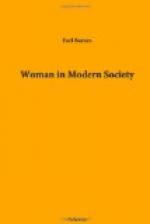The second line of development, which sought to open up all existing schools to girls and women, began when Boston opened a high school for girls in 1825. New York opened a high school for girls three years later.
It was in the West, however, that this movement took strongest root and made most steady advance. The West has always led the East in opening equal opportunity to women, even equal suffrage. The forest and the frontier compel such action even in such commonwealths as Australia, New Zealand and Canada, where there has been no political revolution to hasten it. Labor is scarce; the invading people are intelligent and ambitious for their children and desire them educated. The women must teach them to read and write; the girls learn with their brothers; and so the women master the mysteries of formal education.
Thus it is no accident that Oberlin, in the western forest, was the first college to open its doors to women. Antioch, under Horace Mann’s direction, was, however, the first institution of higher learning to give men and women equal opportunity. The new States of the Mississippi Valley early established State universities. These institutions were little more than seminaries, but the free spirit of the frontier was so strong in them that in 1863 Wisconsin University admitted women to its privileges, and Kansas and Indiana followed shortly after.
It is the year 1870, however, that marks the beginning of a new period in the higher education of women as in so many other lines of advance. In that year, Michigan University, California University and the University of Evanston, adopted co-education. Michigan was just entering on a great career and her influence was very important. There, for the first time, women could follow a university curriculum under the same conditions as men. Two years later, Andrew D. White introduced the Michigan idea at Cornell.
In the forty years since Michigan opened her doors, the advance of women under conditions of co-education has been steady and rapid. In Harvard and Columbia opportunity takes the form of annexes where women can secure almost any educational opportunities they desire. In other universities, like Pennsylvania and Johns Hopkins, women are admitted to graduate study. Most of the institutions of higher education that do not yet admit women are theological and technical schools, or small colleges like Haverford, where there are equivalents in Swarthmore and Bryn Mawr, for women who wish to attend a Friend’s College. A woman can work in almost any important university in America to-day if she cares to do so. In 1910 there were conferred in the United States 12,590 A.B. degrees, and women took 44.1 per cent. of them.




